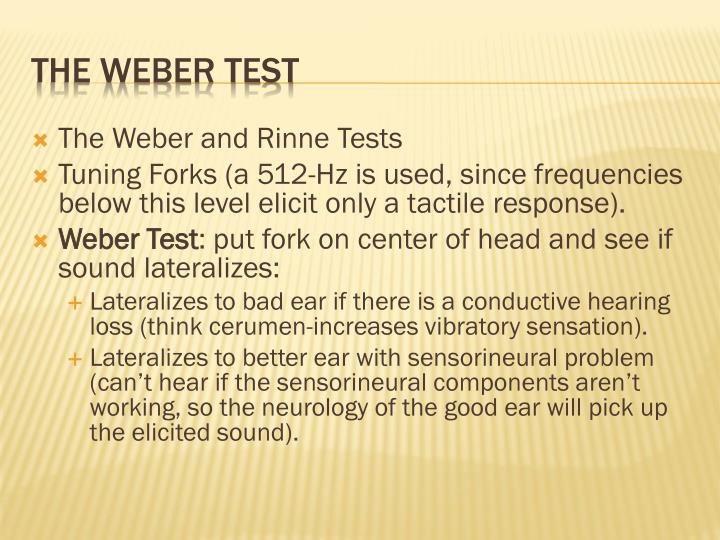


from ear wax impaction, ruptured/ scarred eardrum, or ear ossicle dysfunction).

Still, these and are no replacement for formal audiometry.Īn additional Rinne test determines if unilateral (one-sided) hearing loss is due to sensorineural loss ("nerve deafness") or due to conductive loss (i.e. Nevertheless, by complementing with the Rinne test, a quick screening test can be made. Hearing defects affecting both ears equally, as in Presbycusis will produce an apparently normal test result. It cannot confirm normal hearing because it does not measure sound sensitivity in a quantitative manner. This test is most useful in individuals with hearing that is different between the two ears. The simulation of the Weber test is the basic for the Bing test.Ī patient with a unilateral sensorineural hearing loss would hear the sound loudest in the unaffected ear, because the affected ear is less effective at picking up sound even if it is transmitted directly by conduction into the inner ear. If an occulusion is present, the sound cannot escape and appears louder on the ear with the conductive hearing lossĬonductive hearing loss can be mimicked by plugging one ear with a finger and performing the Rinne and Weber tests, which will help clarify the above. Lower frequency sounds (as made by the 512Hz fork) that are transferred through the bone to the ear canal escapes from the canal. Another theory, however, is based on the occlusion effect described by Tonndorf et al in 1966. This is because the conduction problem masks the ambient noise of the room, whilst the well-functioning inner ear picks the sound up via the bones of the skull causing it to be perceived as a louder sound than in the unaffected ear. It can detect unilateral (one-sided) conductive hearing loss and unilateral sensorineural hearing loss.Ī patient with a unilateral (one-sided) conductive hearing loss would hear the tuning fork loudest in the affected ear. The Weber test is a quick screening test for hearing. Risk calculators and risk factors for Weber testĮditor-In-Chief: C. US National Guidelines Clearinghouse on Weber testĭirections to Hospitals Treating Weber test Ongoing Trials on Weber test at Clinical Early identification of a problem allows you to get early treatment, which in some cases can prevent total hearing loss.(Image courtesy of Charlie Goldberg, M.D., UCSD School of Medicine and VA Medical Center, San Diego, California)Īrticles on Weber test in N Eng J Med, Lancet, BMJ Ongoing exposure to loud noises and aging are common reasons for this type of hearing loss.ĭoctors use both Rinne and Weber tests to evaluate your hearing.

This includes the auditory nerve, hair cells in the inner ear, and other parts of the cochlea. Sensorineural hearing loss occurs when there’s damage to any part of the specialized nervous system of the ear. damage to the small bones within the middle ear.This can be caused by problems in the ear canal, eardrum, or middle ear, such as: Bone conduction hearing occurs through vibrations picked up by the ear’s specialized nervous system.Ī Weber test is another way to evaluate conductive and sensorineural hearing losses.Ĭonductive hearing loss occurs when sound waves are unable to pass through the middle ear to the inner ear. Air conduction hearing occurs through air near the ear, and it involves the ear canal and eardrum. This determination allows a doctor to come up with a treatment plan for your hearing changes.Ī Rinne test evaluates hearing loss by comparing air conduction to bone conduction. They help determine whether you may have conductive or sensorineural hearing loss. Rinne and Weber tests are exams that test for hearing loss.


 0 kommentar(er)
0 kommentar(er)
